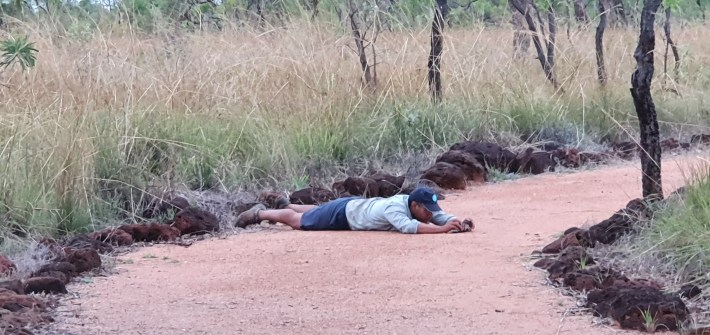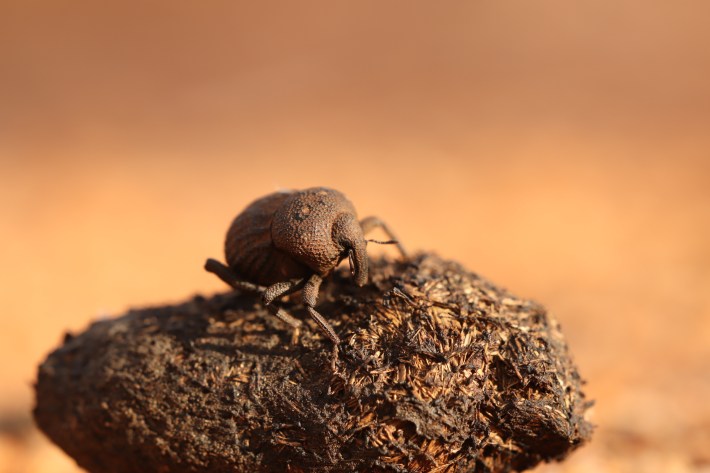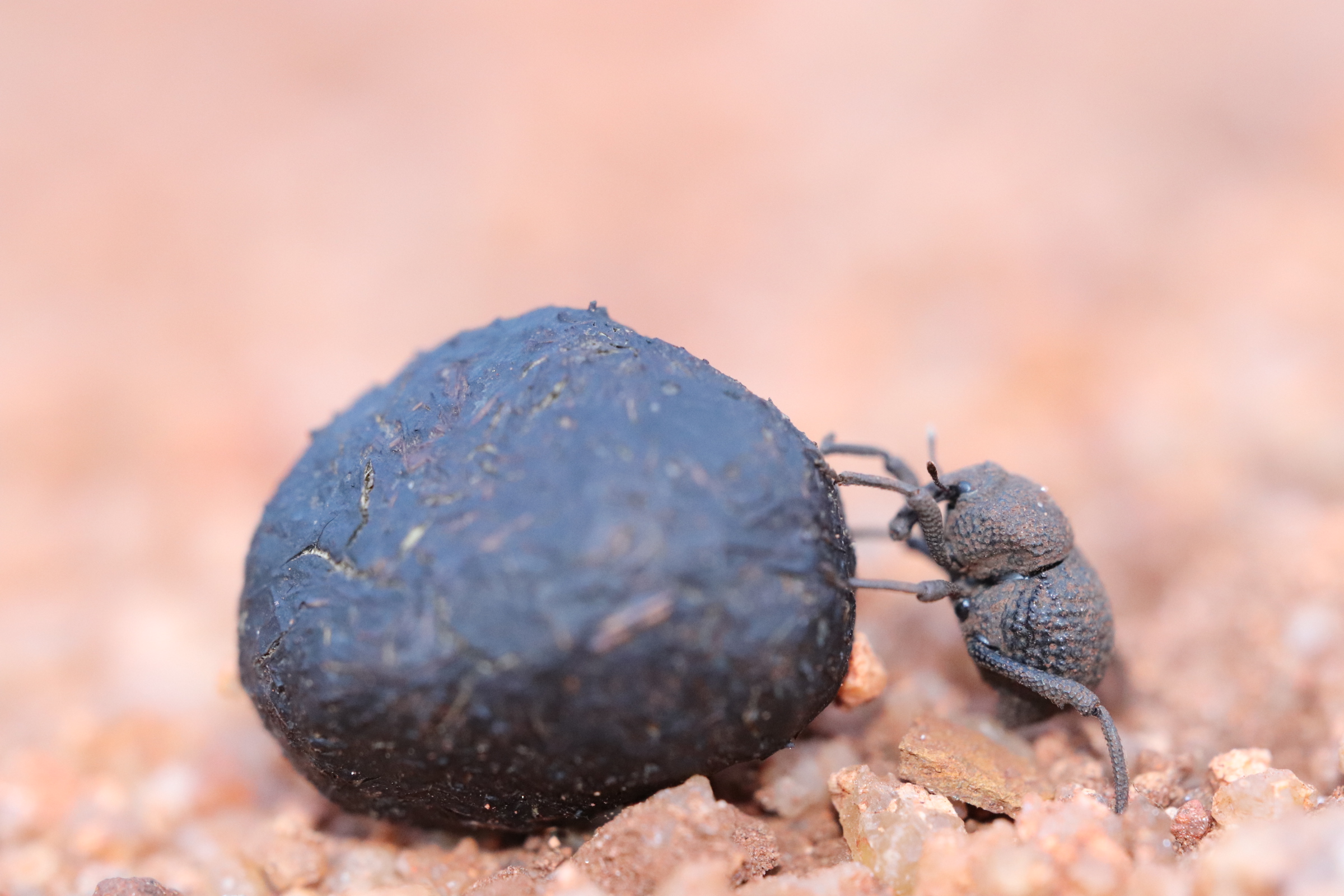A male dung beetle spends its days slicing off juicy chunks of elephant dung and sculpting them into beautiful globes—as small as peas or as big as oranges, depending on the species—and rolling the balls away to bury them to use later for nests and food. The dung balls are relatively enormous, and can weigh many times more than the beetle rolling it. Yet like a spineless Sisyphus, the dung beetle perseveres.
Not all dung beetles roll their precious cargo; in fact, most of the thousands of species of dung beetle either burrow directly inside heftier pats of poo or tunnel through them to drag dung underground. All these dung-rolling, dung-tunneling, and dung-dwelling beetles belong to the subfamily Scarabaeinae, or scarab beetles. Dung-rolling was their domain, and their domain alone—or so scientists thought.
More than 60 years ago, the Australian naturalist Joseph Leathom Hole Wassell witnessed an entirely different kind of beetle rolling dung across distances of nearly six feet. Strangely, this roller was not a scarab beetle, but a weevil—a distantly related superfamily of beetles known for their long snouts and elbow-like antennae. But this observation faded into obscurity over the years until a group of researchers tracked down the wayward weevils, filmed their dung-rolling, and published their findings in the journal Annales Zoologici. "This is an extraordinary case of convergence in biology and behavior," Hermes E. Escalona, a researcher at the Australian National Insect Collection of CSIRO and an author on the paper, wrote in an email.
Wassell had noticed the weevils rolling wallaby and kangaroo dung on his ranch in the remote Cape York Peninsula, according to Geoff Monteith, an honorary researcher at the Queensland Museum who helped review the paper. Wassell had married into a capacious cattle ranch but was much more interested in beetles than bovines, so he often roamed the property on a horse or Land Rover looking for plants and animals, Monteith said. The dung-rolling weevils were all in the genus Tentegia, and Wassell collected several specimens.
In 1964, the 22-year-old Monteith spent a week with Wassell, but it was too late in the season to observe any Tentegia weevils. But Monteith helped to compile Wassell's existing specimens into a paper about the natural history of the weevils, which Wassell did not live to see published. Then the weevils went unstudied again until an entomologist named Elwood C. Zimmerman picked up the cause, illustrating the eight species in Tentegia, as well as a marsupial dung pellet that had been hollowed out by a larva of the weevil T. stupida. (Although the name now appears derogatory, at the time it signified a lack of notable characteristics such as horns or bright colors, Escalona said.)
Escalona had read about Tentegia's alleged dung-rolling in various beetle texts, and his colleague Rolf Oberprieler, another author on the paper, had shown him Wassell's original weevil samples, some still tinged with dung. After seeing a blurry video of T. stupida on the internet, Escalona wondered if he could film the weevils in flagrante dung-licto [ed: this is awful, please cut].
The effort took two to three years, running down old records of Tentegia around Queensland. Eventually, after traveling to Undara Volcanic National Park in search of cave-dwelling weevils, Escalona saw a Tentegia weevil sitting on a rock. Soon, he'd found a whole population and could finally capture the weevils on candid camera. "I couldn’t believe about a little fella rolling his pellet up a rock with strong determination," Escalona said. "When he 'saw' me stopped and dropped the pellet but when I put it back he hesitated for a second but keep rolling it up."

Scarab beetles are not the only beetles to feed on dung; spider beetles and deathwatch beetles also enjoy a fecal feast, according to Keith Philips, an entomologist at Western Kentucky University who was not involved with the new paper. "But what is spectacular is that these weevils actually relocate the dung," Philips wrote in an email.
"The parallel with classic dung beetle behavior is very striking," Monteith said, adding that the weevils' behavior of rolling dung and raising their larvae inside the pellets is "a uniquely Australian situation and quite strange." Scarab beetles rely on fresh, moist dung, a resource that comes with competition; some species of Australian scarab beetles beat the rush by clinging to the anuses of kangaroos and wallabies to harvest the pellets the second they are excreted.
But on the dry continent of Australia, mammals conserve water by producing dry dung pellets of undigested plant fibers—which is quite similar to wood, the normal diet of weevil larvae. So the plant-eating weevils have adapted to exploit Australia's ample resource of desiccated droppings. But the transition from passively living on plants to actively harvesting dung is extraordinary, and has not been recorded in any other weevil anywhere else on Earth, the authors wrote.

Alas, the weevils do not roll dung as elegantly as scarab beetles, which have large, flattened front legs that help to tamp the dung into a sphere. Nocturnal dung beetles even stargaze to navigate as they roll their dung balls to safety. "Dung beetles have well-developed techniques for dung-rolling, while Tentegia is just 'learning,'" Escalona said. He added that the researchers are only certain this behavior happens in two species, including T. stupida—who is, etymologically speaking, the lesser of two weevils—but suggest all Tentegia weevils may roll dung based on their morphology.
Tentegia weevils are clumsy and cannot fly, restricting their ranges to small areas—essentially as far as they care to walk. "These beetles, like many others, are incredibly useful at identifying areas that have unique faunas but are not yet protected," Philips said. The authors hope the discovery of this deviant dung-rolling deportment may encourage the weevils' conservation and further research into the genus.
Mystery still surrounds these weevils. How exactly did they evolve such behavior? Do they, too, seek guidance from the Milky Way? Could a weevil roll the cubic poops of a wombat? Perhaps the gaps in our knowledge are our fated burden, our enormous dung ball, forever lugging it uphill as we inch closer toward truth.






